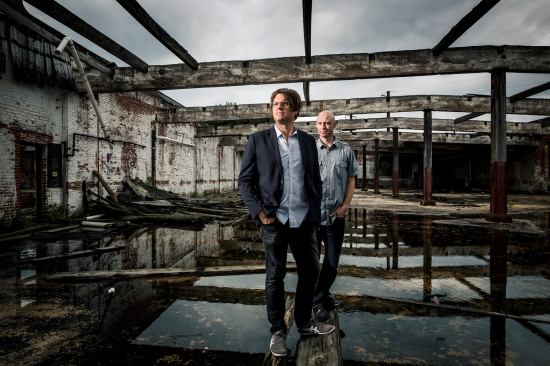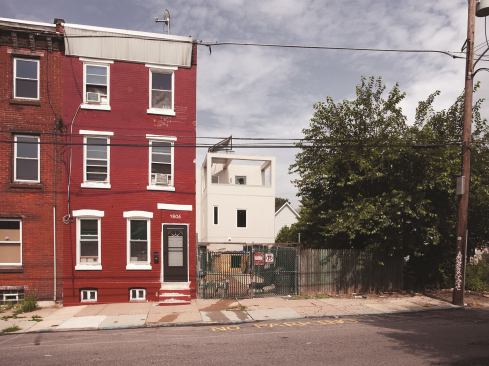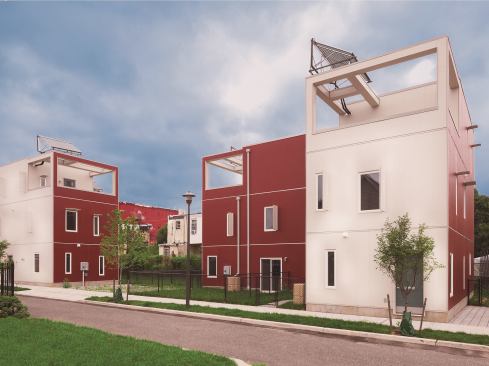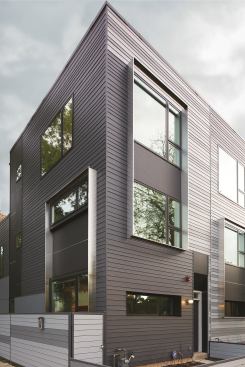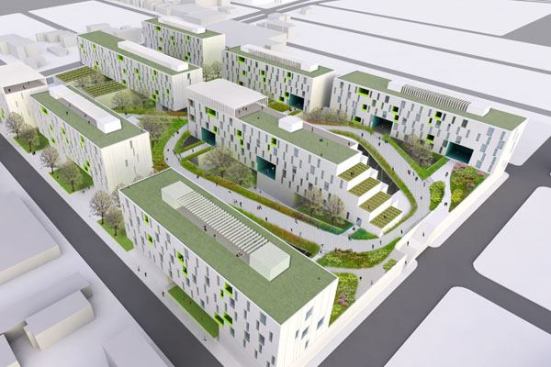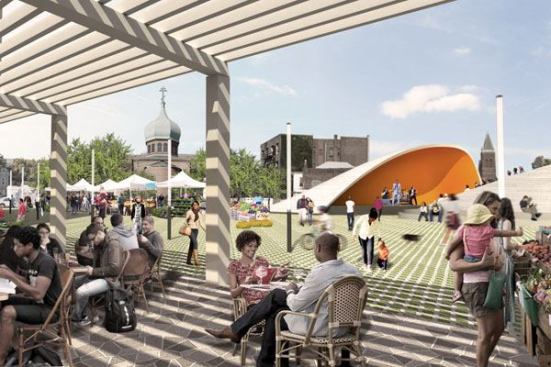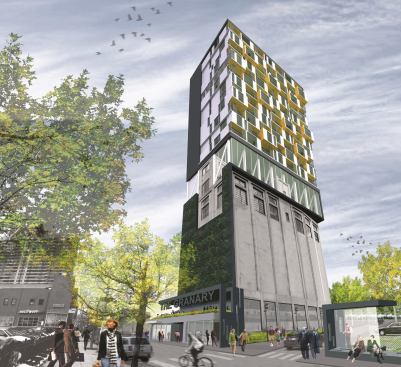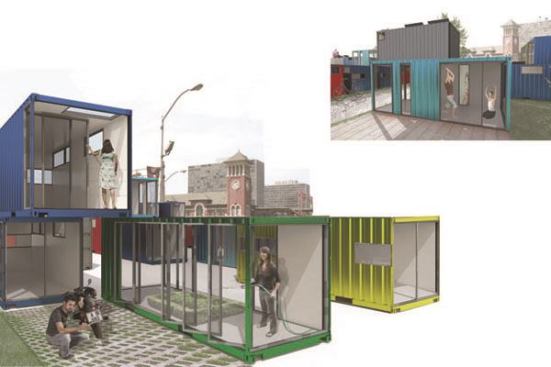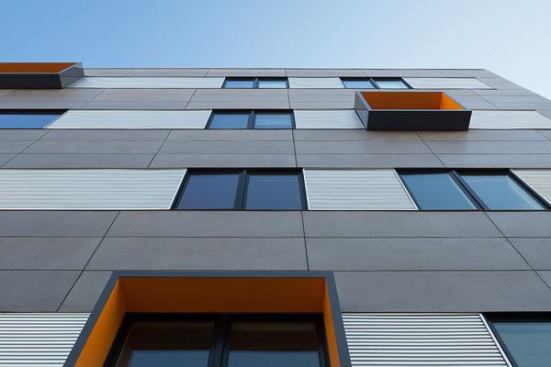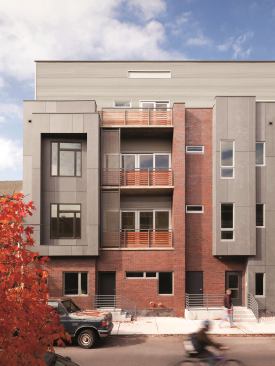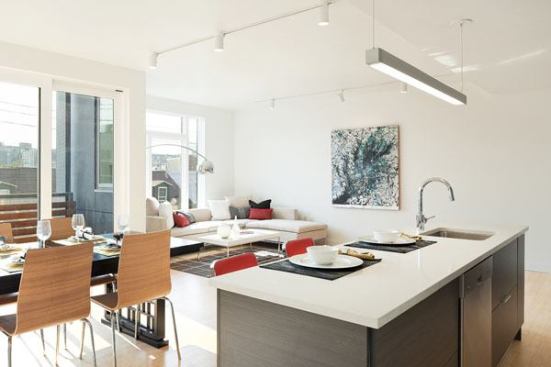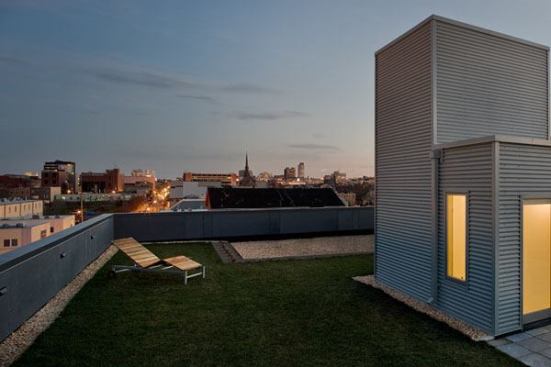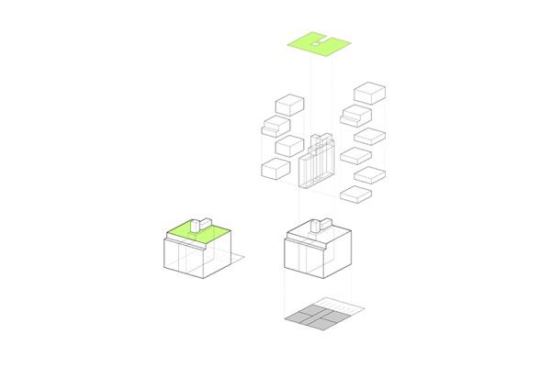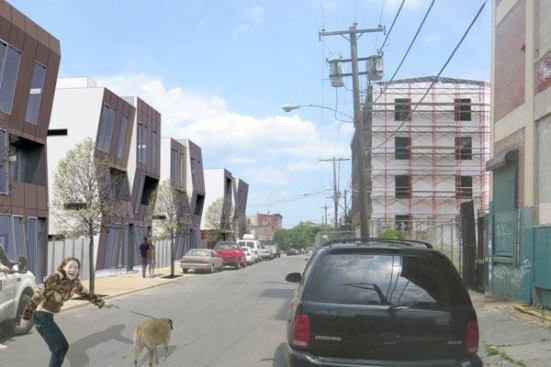Chris Crisman Photography LLC
Brian Phillips (left) and Daryn Edwards of Philadelphia-based In…
On the website for Flexhouse 2, a string of 15 slate-colored row houses designed by Interface Studio Architects of Philadelphia for Ranquist Development of Chicago, there’s an unusually compelling bit of marketing-speak: “The Flexhouse is a new type of home that is tuned to the ‘new normal’ of the twenty-first century.” The new normal? What exactly does that mean? “The houses are modest, efficient, urban, and cool,” the copy continues, “appealing to urban lifestyles that seek to make sustainable lifestyle choices.”
Brian Phillips, the 42-year-old founding principal of Interface Studio Architects (ISA), an eight-person firm, is nothing if not an apostle for the new normal. His ambitious aim: to rethink and maximize the potential of urban-house design for the new city-loving generation.
Phillips, AIA, who made Philadelphia Magazine’s 2012 list of the smartest people in town, is tall, soft spoken, somewhat shaggy, and partial to blue jeans, black T-shirts, and sneakers. He grew up in the Lehigh Valley, north of Philly, but attended college at the University of Oklahoma, attracted by that school’s meteorology program. He eventually decided he was more interested in buildings than tornadoes, got his master’s in architecture at the University of Pennsylvania, and was hired right out of grad school. “I had never worked in a firm, maybe had never set foot in a firm, and I was recruited by Wallace Roberts & Todd (WRT).”
He stayed at the large Philly-based firm for seven years, working as a “utility player,” often collaborating on landscape or urban planning projects. But at a certain point he realized that “you either become further entrenched or figure out what you’re going to do on your own.”
On the day his son was born in 2005, Phillips set up his own shop. Located in the Crane Arts Building north of Center City, ISA’s office is shoehorned into a narrow space with no real boundary between architects’ individual work areas and the conference zone. There’s no reception area or ceremonial space of any kind. It’s all architecture all the time.
When Phillips launched the firm (initially in partnership with another WRT staffer, urban planner Scott Page, who now practices separately as Interface Studio), he quickly found residential work. The firm’s first built project, a 10-unit condo building for a first-time developer, reflected “the irrational exuberance of the housing bubble,” Phillips says. Skypark, as the building is called, is an unremarkable composition of brick and corrugated metal notable for its communal green roof. “We learned about union labor,” Phillips recalls with a sigh. “So much we learned … Philly is a city with very high construction costs and a soft market—the costs of New York and the tenant market of Baltimore.”
So it seems fitting that the project that profoundly shaped Phillips’s vision and the firm’s reputation was about cutting costs to the bare minimum. It began inauspiciously in 2007 when another untested developer, Chad Ludeman, the then-29-year-old founder of a fledging company called Postgreen, showed up with the idea of building houses that would be appealing and affordable to younger buyers. Specifically, 1,000-square-foot modern homes, with all the features necessary for LEED certification—recycled materials, state-of-the-art insulation, passive solar, and Energy Star appliances—on a construction budget of $100,000, with a projected sale price in the low $200s. Small, urban, fashionable, and cheap remained an untested combination in the urban housing market, and Philly, with its overabundance of vacant lots, was the perfect place to do it.
Ludeman said that he’d researched every architecture firm in the city and determined that ISA came closest to sharing his worldview. If that wasn’t true at the outset, it certainly was by the time the first house was completed. There was something transformative about the intensity of the work that the two young firms did together. “We went through three or four iterations of what the building would be before we got to the core envelope,” says Ludeman, who kept giving Phillips constraints. For starters, the façade had to be incredibly simple. Ludeman describes the rules this way: “No bump outs and just a flat square kind of façade.” Next, there couldn’t be a lot of surface area devoted to windows, an unusual request for a modern-style home. The windows, according to Ludeman, had to be used sparingly and be “cost effective and energy efficient.”
“And then,” Ludeman adds, “we limited him to one façade material only, which on the first couple of projects was fiber cement.” As Phillips recalls: “Initially, Chad believed in that flat, single material. If we were really going to hit $100 a square foot, we had to be really honest and fastidious about how little we were going to do.” On one of the later houses, Phillips got clever and offset the flatness by silk-screening a cloud pattern on the exterior.
Ludeman has so far built 15 homes, most a bit larger, somewhat more refined, and more expensive than the original 100K House. All share a stripped down, boxy aesthetic. Today, the East Kensington neighborhood where most of the Postgreen houses have been built—Phillips refers to it as the 100K ghetto—has a dwindling supply of vacant lots. The new homes that seem to stand on every corner weren’t all built by Ludeman: His success has spawned knockoffs—smallish, modern, monochrome cement-board townhouses built by other developers. Ludeman, meanwhile, is about to break ground on several larger projects, some 90 units in all, designed by Phillips and other local architects.
The 100K House clearly kicked off a local trend toward modern, green, modest housing, and it also had an impact on Phillips, who was able to refine his architectural philosophy to an unusual degree. He wants to rethink the American dream, to transplant that set of desires that we associate with the suburbs to the city. “We’ve talked a lot about Generation Y and first-time home buyers, and what ever happened to the starter home. And this idea that when a 30-year-old couple is buying a house, should they be buying their parents’ house? Can they have less storage? Can it be more energy efficient? Does it really have to be maxing out the zoning envelope? Can it be appropriately sized for a lifestyle that [embraces a] smaller footprint?”
His vision is the product of a Philadelphia that the demographers haven’t quite acknowledged: young, hip, entrepreneurial. The fact that Philly’s population curve has turned upward for the first time since the 1950s is generally attributed to an influx of Asian and Hispanic immigrants, but a visit to neighborhoods like Northern Liberties, Fishtown, and East Kensington makes it obvious that one component of that upswing is the familiar scenario of well-educated, relatively affluent 20- and 30-year-old homesteaders transforming the urban landscape, one coffee bar at a time.
One of the reasons that Ludeman initially approached ISA was a competition that the firm had won in 2006, unbuilt until recently, for a cluster of LEED certified affordable houses. For a nonprofit community developer called Asociación Puertorriqueños en Marcha (APM), ISA designed 13 homes—each 1,350 square feet, with three bedrooms, a small yard, a parking space, a roof deck, a solar array, rain barrels, and energy efficient systems. Built for $300,000 a piece, they’re currently being sold for a subsidized purchase price of $150,000.
Located along narrow Sheridan Street, the development is startling, in part because the houses, crisp three-story rectangles of white and maroon, look like they’ve been air lifted in from Scandinavia. Walking up Sheridan, Phillips is delighted by an indication of human habitation (10 of the 13 units have been sold): “I love that little doormat,” he says, snapping a photo of a flowery rectangle a new homeowner has slapped directly onto the sidewalk. Equally incongruous is the much larger adjacent development, also by APM, which appears to have been imported from Any Suburb, USA. “There are a lot of funny urban relationships in Philly,” he acknowledges.
Rose Gray, APM’s senior vice president of community and economic development, sounds lukewarm about the mix of typologies. She regards the suburban-style houses with their beige siding and generous lawns as what the organization’s home buyers “typically” want. “Our community likes the two stories with more of a backyard.” And while APM customarily sells its homes to African American and Hispanic families, the Sheridan houses have mostly appealed to single buyers, many of them Asian.
Unlike Gray, Phillips doesn’t believe “suburban patterns” make sense in historically dense urban neighborhoods. “The density of Sheridan is more like the existing context of old row homes,” Phillips says. “I think when you offer low density in an urban environment, it may awaken an unrealistic expectation in home buyers in what they should expect from city living.”
Fortunately, one of Gray’s former APM colleagues, Manuel Delgado, now the executive director of the Cramer Hill Community Development Corporation in nearby Camden, N.J., agrees with Phillips. “When you’re doing subsidized housing, particularly in urban areas,” Delgado says, “architecture firms generally give you an off-the-shelf design. When you go with that approach, it doesn’t fit within the context. In Philadelphia, a lot of the stuff that was built, and here in Camden as well, is really suburban-style housing.”
ISA designed two sets of 10-unit developments for Camden’s Cramer Hill neighborhood, after Phillips participated in a series of meetings “where he just talked with residents about what they’d like to see built next to them or down the street.” The participants also discussed how to attract new residents to town. “So he sort of balances both of those, building something that’s comfortable for the community but also exciting for new residents,” says Delgado.
How do you attract new home buyers to Camden, which currently tops the FBI’s list of most dangerous small cities? Delgado believes the prospect of living in a house that supplies all its own energy needs, saving homeowners on utilities, certainly helps. And the shedlike buildings that ISA designed for Cramer Hill—construction is scheduled to start soon—are overtly cheerful: Crayola colored with rear decks and side porches. At about 1,300 square feet, they’ll sell for somewhere around $150,000. Less enticing to newcomers, perhaps, are the project’s Metal Houses, which are clad in corrugated metal with front porches that look like sculptural cages. Because of the high crime rate, most Camden residents enclose their porches with security bars. Says Delgado, “We made a really, really conscious effort to make sure the bars were incorporated into the design, and it becomes an attractive feature as you’re looking down the street at the houses.”
That Phillips can successfully take his scaled-back version of the American Dream down-market isn’t surprising, but the approach is also upwardly mobile. That’s where the “new normal” comes in. Developer Bob Ranquist, known for planting luxury condos in lately fashionable neighborhoods, hired ISA for his first post-recession project in Logan Square, just northwest of Chicago’s boho chic Wicker Park.
The new normal? “To me that means we’re designing the homes simpler now. They’re not as fussy. They’re not as fancy. They’re smaller. They’re more efficient,” Ranquist says. The first Flexhouse project was completed earlier this year, offering home buyers a stripped-down version of the upscale urban townhouse. The approach is “market driven,” Ranquist says. “Much of the inventory on the market neglects to address the needs and desires of the young urban couple or family who is willing to live in an up-and-coming area.”
Ranquist regards the Philadelphia 100K Houses as “instrumental” in his thinking for the Flexhouse project in Chicago. The row houses, which sell for upwards of $400,000, have 1,800 square feet on three levels, with no basement. The detailing and finishes are slicker than those favored by Ludeman. The gray-on-gray palette recalls the first 100K House, but the façades are not nearly as flat, with more generous glazing and big protruding stainless steel window frames. Inside, the kitchens clearly feature pricier appliances and finishes than those in Philly, but the minimalistic approach is similar.
So far, Phillips has exported what he’s learned in Philly to Camden, Chicago, and Boston, where ISA designed four net-positive protoype houses as part of a city initiative. He’s also doing some conceptual work in Detroit, trying to figure out if it’s possible to sell a low-cost, energy-efficient building envelope that would allow handy home buyers to build out an interior over time. That would be the 10K House. And he’s working with a Miami-based community group that’s trying to introduce the low-rise apartment block to a city dominated by towers and detached single-family houses. He argues that architects should help serve as “accelerants for conversations, changing the way people perceive what’s possible.”
To that end, Phillips is using the key question about ordinary housing in this country—why isn’t it better?—as a way to change the nature of cities. Philadelphia is still his first and best laboratory: There’s room there for “risk and innovation,” he says, because Philly remains one of the biggest, poorest, least educated cities in America. In other words, the new normal is about extracting an upside from the downside.

